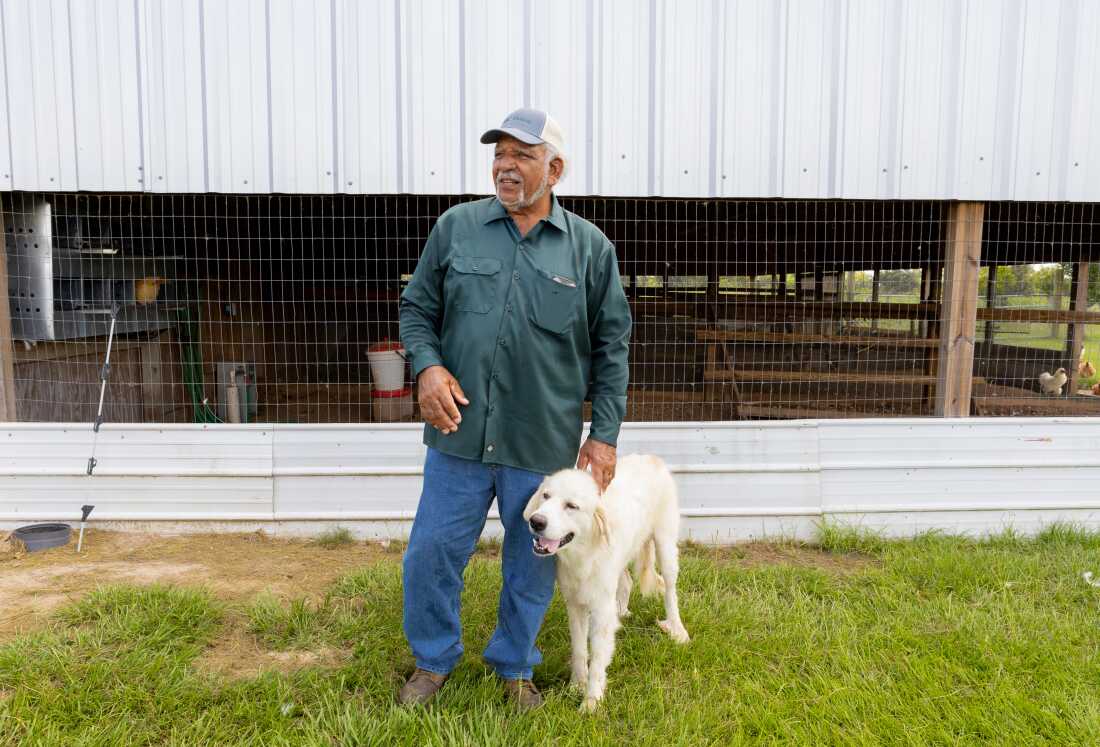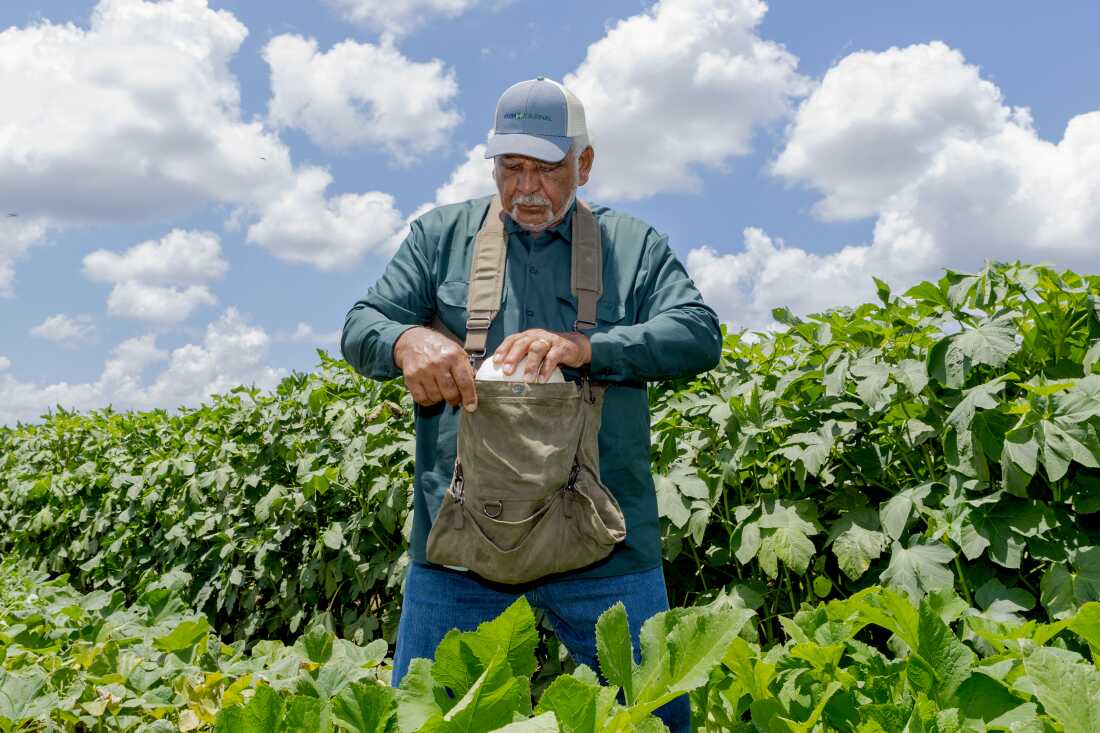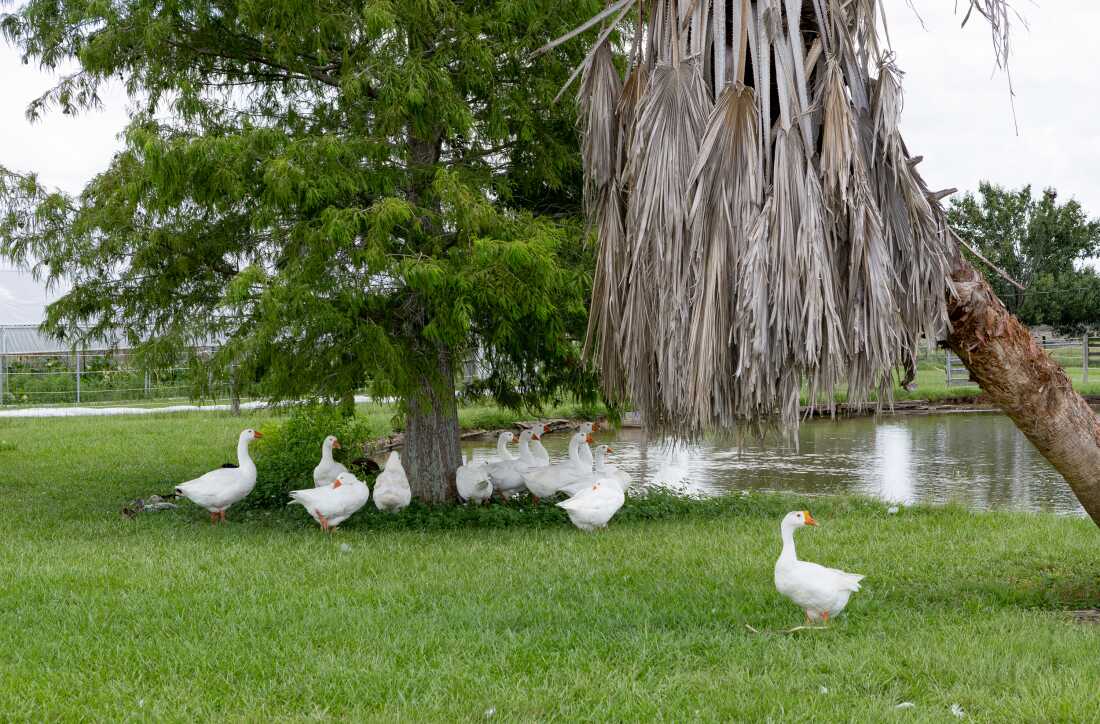
Hillary Gobert and her livestock guard dog, Bella, at Driftwood Ranch in Iowa, Louisiana. Bella protects farm animals from predators such as coyotes.
Leslie Gamboni
Hide title
change title
Leslie Gamboni
Climate change affects our food and our food affects the weather. NPR has a week devoted to it Stories and conversations About looking for solutions
A number of small black-owned farms in the South Bay grow crops with climate in mind. Hillary Gobert is one of them. He owns a 65-acre farm in Iowa, La. started farming in 2020. He has been trying to improve the soil ever since. To do this, he rotates crops and uses cover crops to keep nutrients in the ground. The land currently supports a variety of crops, including okra, figs, Asian eggplant, and watermelon.
Guber also grows rice at Driftwood Farm. Rice is usually grown by flooding fields with water, producing methane, a powerful planet-warming gas. So Guber grows his rice using drip irrigation to deliver water directly to the roots.

“In our effort to reduce greenhouse gas emissions, we’re looking for ways to grow rice as an alternative to constantly flooding fields, as we’ve done in Louisiana for hundreds of years,” says Gobert.
Using less water to grow rice is an example of what the USDA calls climate-smart agriculture. Cover crops (such as red clover and cereal rye), no-till farming, and crop rotation are all considered good practices for climate and agriculture. The idea is that farmers can reduce the pollution that contributes to human-caused climate change while still producing enough food for a living.
The science is not clear on climate-smart agriculture impacts. Still, there are benefits for farmers and communities, says Paul West, senior scientist at the Drawdown Project who researches ecosystems and agriculture.

Left: Guber dries shallots in his field. Owner of Driftwood Farm, he practices climate-smart farming practices. Correct: Gobert uses sunflowers to attract pollinators and divert pests from crops.
Leslie Gamboni
Hide title
change title
Leslie Gamboni
“I think a lot of climate-smart agriculture practices are very good for a farmer in terms of soil health and long-term productivity,” West says.
Gobert comes from generations of farmers who believed the land could provide everything a family needed to survive. He says his father left him with valuable advice that Gobert carries with him to this day.
One of the things he said as a kid that I’ll never forget is that all these inputs we put into our farm are great and we can make money from it, but one day Ma Gobert says I’m paying for not taking care of the land.
Now, he wants to leave the farm better than he found it for the next generation of farmers in his family.
Work with small farm owners
In 2023, the Biden administration announced that $20 billion would be spent on climate-smart agriculture over the next five years. Some farmers are using federal money to help implement these ideas. Other farmers are learning how to do climate smart farming through black land grant universities and colleges.
John Coleman manages Alcorn State University’s demonstration farm in Mound Bayou, in the Mississippi Delta. In mid-June, he showed a group of small farm owners and others around, pointing out crops such as purple-skinned peas growing on the farm. He also demonstrated practices used on the farm such as limited irrigation and cover cropping.
“It’s to help protect our soil that we’re losing. You can see global warming and things like that, so we’re trying to protect the land,” Coleman says.

Gobert, of Driftwood Farm, harvests white bush squash. Gobert practices agriculture with the weather in mind. He rotates crops and grows rice by applying water directly to the roots instead of flooding the fields, which produces methane, a powerful planet-warming gas.
Leslie Gamboni
Hide title
change title
Leslie Gamboni
The Department of Agriculture is partnering with black colleges and universities such as Alcorn and other institutions through the Climate Smart Commodities Partnership. The aim is to work with small-scale farmers on projects that help farmers, ranchers and private forest owners cope with climate change.
Working with black land-grant universities, also known as the 1890s, is not a new idea, says Daniel Collins, professor of plant pathology at Alcorn.
“The 1890s system has a long history of working with small farmers, starting with George Washington Carver, Booker Whatley,” says Collins.
Carver and Whatley were big fans of environmental farming practices. Carver introduced crop rotation, using peanuts and other crops to reintroduce nutrients and nitrogen to the soil. Whatley helped develop a community-supported agriculture model to help small black-owned farms struggling with limited resources.
Now Alcorn State University and other groups are adding to that long history. Through funding from the Department of Agriculture, they are enrolling farmers in a project to measure how much carbon dioxide is stored in the soil when using climate-smart methods. The study will take five years to complete, but the researchers hope that with the help of black farmers, they will find out whether climate-smart agriculture actually reduces greenhouse gas emissions.

Small farm owners, as well as students and faculty from Florida A&M University, the University of Florida and Alcorn State University, examine plants at Start 2 Finish Farm in Marks, Miss., on June 19. This is part of a two-day mini-competition. Integrated pest management in farm climate workshop covering topics such as organic pest control methods, soil amendment, cover crops and soil and water management.
Maya Miller/Gulf Countries Newsroom
Hide title
change title
Maya Miller/Gulf Countries Newsroom
The role of cooperative agriculture
Through funding and research, climate-smart agriculture is expanding in the South Bay. Farmers like Chris Mews are helping others learn how. In 2015, he started Muse 3 Farm with his brothers in Greensburg, LA. launched Now, they help other black farmers on their small farm plots.
“One of the things we’ve been working with other local farmers to do is soil health,” Muse says. How can you improve the health of your soil without using too many additives like artificial fertilizers, herbicides, pesticides?
On past farm tours, Mews and his brothers would ask these same farmers if they had contracts with the Department of Agriculture to protect the environment. No one raises their hand. Given that historically, black farmers have been wary of the government, Muse says that response was understandable. A federal class action lawsuit called Pigford v. Glickman The case exposed years of loan discrimination against black farmers.

Ducks seek shade under the trees on July 16 at Driftwood Farm. Gobert integrates livestock with crop production to increase soil health and biodiversity.
Leslie Gamboni
Hide title
change title
Leslie Gamboni
Muse explains that agricultural cooperatives have historically served as intermediaries for black farmers who felt they were being treated unfairly. Now that funding for climate-smart agriculture is available, the same groups are working to ensure that money to help climate-smart agriculture reaches small-scale and underserved farmers. This is a step to ensure that the historical injustices faced by black owners of small farms are not repeated.
“What I tell my little black farmers is the funding is there now,” Muse says. what do you want to do Do you get your share of the budget or do you let the next farmer take your share?”
It’s not just about justice. “Climate-smart agriculture is also about the impact that climate change is having on farmers right now,” Muse says. Last year, Louisiana experienced a drought. Muse is concerned about how to protect the earth.
“We’ve got to do some sort of sustainability thing. If not, you know, we’re doomed,” Muse says.
He thinks climate-smart agriculture can help turn the tide and help farmers protect their land for generations to come.
#small #farms #owned #blacks #grow #crops #account #climate